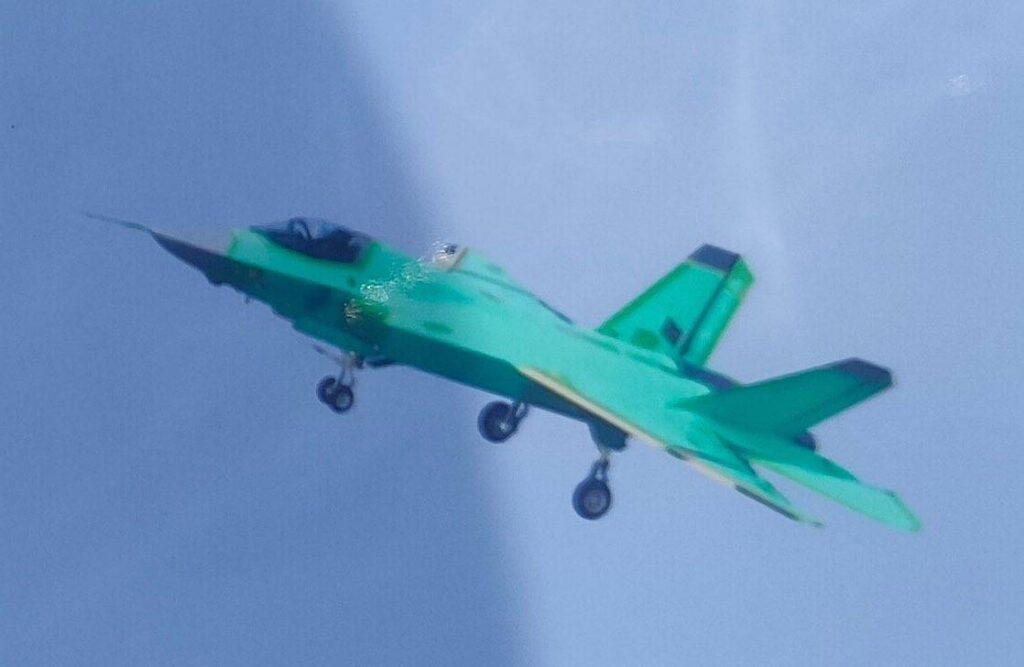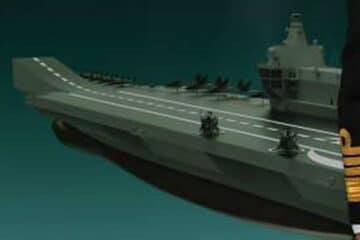The PLAN now has two of the STOBAR (Short Take-Off But Arrested Recovery) aircraft carriers in service. Those use a ski-jump to launch the aircraft. It comes with limitations: Aircraft need a high thrust to weight ratio and their operational payload may be limited. China is currently building a third carrier near Shanghai: The Type-003 will be massive. It is roughly comparable to the U.S. Navy’s Ford Class. This will be a CATOBAR (catapult-assisted take-off but arrested recovery) design. Thanks to its three EMALS (electro-magnetic aircraft launch system) catapults, it will be able to launch the new aircraft spotted in flight today.
J-35 / J-XY stealth fighter

The official designation of China’s new twin-engine stealth fighter aircraft is not known yet. Most open sources calls it “J-35” or “J-XY), some even calls it a variant of the FC-31. A full-size model of the stealth plane first appeared in June this year at land based testing facility: A full-sized mock-up of a real Chinese Navy aircraft carrier, located at Wuhan. Naval News‘ regular contributor H I Sutton covered at length the development at the time, pointing out the similarities between the aircraft and the FC-31.
The airframe complies with the new norms of stealthy aircraft design. Carefully aligned angles, a mix of sharp chines and blended surfaces, and sawtooth edges to panels. Over the course of its development, since its first flight in 2013. Three prototypes have flown with the latest, in 2020, being considered closer to a production aircraft.
A internal weapons bay spans the lower fuselage a lot like the F-22. This can carry the PL-15 medium range air-air missile. Like the F-35, additional weapons can be carried in underwing hardpoints. These will increase the aircraft’s radar cross-section so they are not normally seen.
H I Sutton
KJ-600 airborne early warning & Control (AEW&C)

Also spotted in flight (when, we don’t know but the pictures were released today) is the KJ-600. This is the Chinese analogue to the U.S. Navy’s E-2D Advanced Hawkeye, and it looks remarkably similar. The mock-up appeared on the deck of the concrete carrier in 2017. The prototype first flew in August or September 2020. While the real thing is not identical to the mock-up, it is very close.
Not much is known about its sensor suite but Henri Kenhmann from the Eastpendulum blog, a very reliable source on the Chinese military, previously shared the following with us:
“As for the type of radar selected for the platform, rumors mention an active electronically scanned array (AESA) radar mounted on a rotating disk. This would favor the “width” of the radar (therefore the number of installed modules) the power and the range, to the detriment of the refresh rate had it been a three-sided fixed configuration (as is the case with the KJ-2000 and the KJ-500 land-based AWACS). A quick calculation shows that in “back-to-back” configuration, the “width” of each radar face is about 15% larger than in the configuration of three fixed faces, but all of this remains to be confirmed.”






